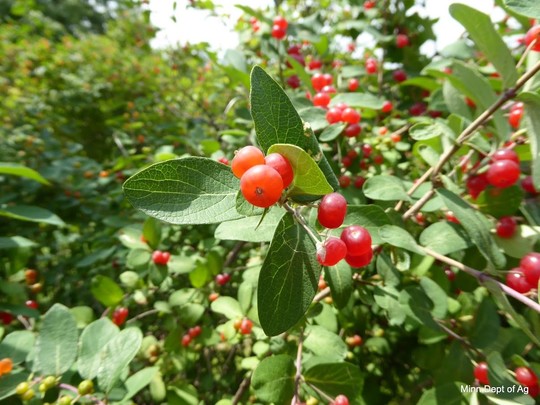|
Having trouble viewing this email? View it as a Web page.
October 3, 2022
October Weed of the Month: Non-native Bush Honeysuckles in Minnesota
Maggie Barnick, Minnesota Department of Agriculture
Because non-native bush honeysuckles have pretty flowers and thrive in a variety of soil conditions, they were planted as ornamentals, for erosion control purposes, and as wildlife habitat. Now we know exotic honeysuckle are detrimental to our forests, spreading and outcompeting native forest understory plant species.
 Fall berries on a non-native bush honeysuckle.
Click here to download the photo
Non-native honeysuckles leaf out earlier and hold their leaves later than native shrubs, shading out native plants. They also begin absorbing nutrients and water earlier in the growing season, depriving our native plants of these critical resources. In the fall, you can notice their colorful red to orange-yellow berries, which are eaten and distributed by bird species, and although they have little actual nutritional value for our native birds, this creates an important vehicle of spread into new areas. Finally, their shallow root systems leave the soils more prone to erosion.
 Non-native bush honeysuckle in flower.
Click here to download the photo
There are 180 species in the Lonicera genus worldwide. In Minnesota, we have four non-native bush honeysuckle species of concern: Morrow’s, Bell’s, Tatarian, and Amur honeysuckles. Bell’s honeysuckle is a hybrid of Tatarian and Morrow’s honeysuckle. Morrow’s, Bell’s, and Tatarian honeysuckle are all widespread in Minnesota. Bell’s honeysuckle is thought to be the most common. Amur honeysuckle is not known to be widespread in Minnesota but exhibits similar invasive characteristics as the other three and is a problem in other parts of the Midwest. Amur honeysuckle has the most distinctive characteristics of the four species. It has leaves that are lance shaped with tapered, pointy tips. Its fruits and flowers are nearly stalkless. Non-native bush honeysuckle can be quite difficult to distinguish from one another. The four species exhibit slightly different characteristics in flower color, leaf pubescence, fruit color, and size, too. A guide to distinguishing non-native from native honeysuckles is on pages 14-15 of "Mistaken Identity? Invasive Plants and their Native Look-alikes."
 Minnesota has several native species of honeysuckle that differ greatly from non-native invasive honeysuckle. One key distinction is the pith on twigs that are two years or older. In non-native bush honeysuckle species, the pith will always be hollow whereas the pith of native honeysuckle species is solid.
Click here to download the photo
The four non-native bush honeysuckles are Restricted Noxious Weeds, meaning the importation, sale, and transportation of their propagating parts in the state is prohibited. Japanese honeysuckle (L. japonica) is also regulated in Minnesota but is a woody vine and not similar to the four bush honeysuckles focused on in this article.
For additional information on non-native honeysuckles, visit the Minnesota Department of Agriculture’s website or the Minnesota Department of Natural Resource’s website.
MEDIA: For more information on Weed of the Month, contact Allen Sommerfeld, MDA Communications, at allen.sommerfeld@state.mn.us or 651-201-6185
|